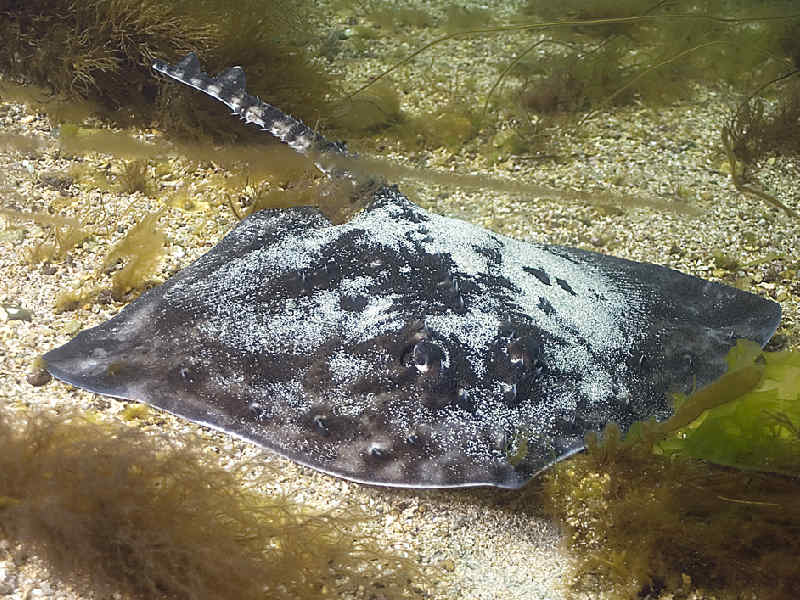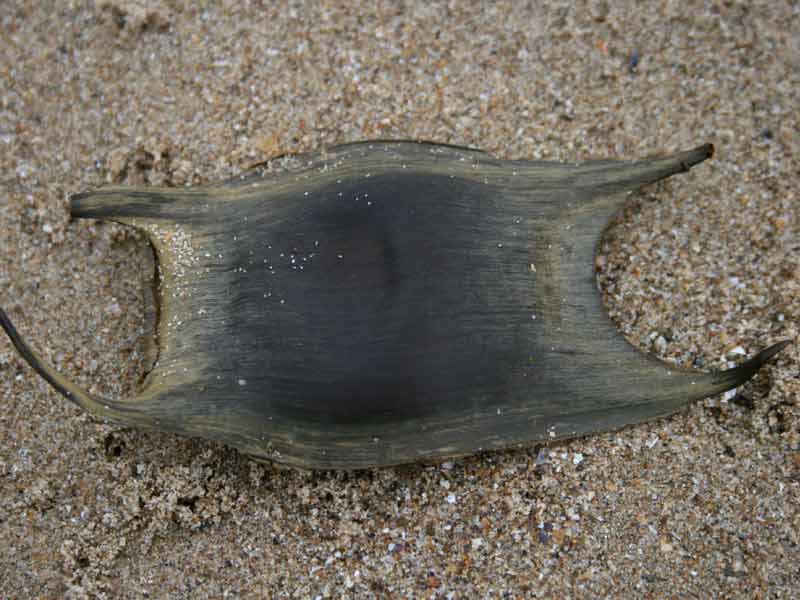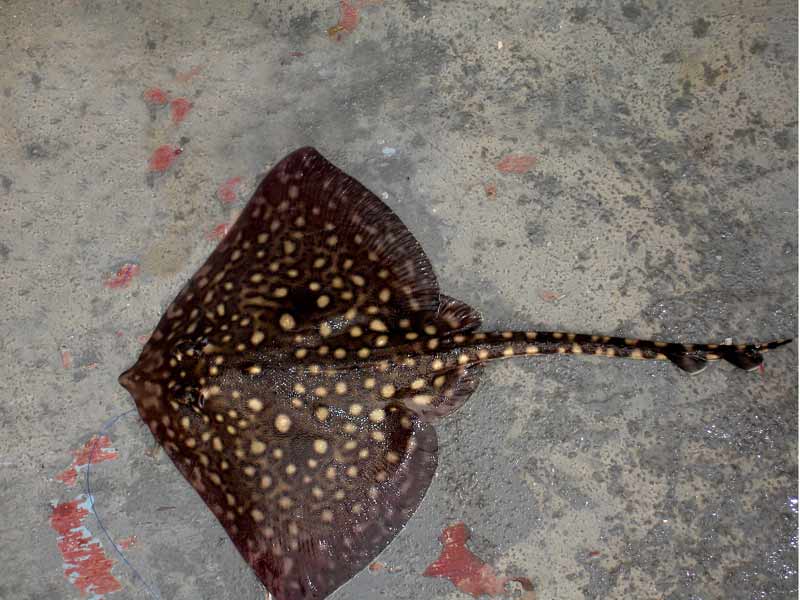Thornback ray (Raja clavata)
Distribution data supplied by the Ocean Biodiversity Information System (OBIS). To interrogate UK data visit the NBN Atlas.Map Help
| Researched by | Emma Snowden | Refereed by | This information is not refereed |
| Authority | Linnaeus, 1758 | ||
| Other common names | - | Synonyms | - |
Summary
Description
A short-snouted ray with typical diamond shape and sharply angled pectoral fins approaching 90 degrees. The colour is variable, usually a mottled, blotchy brown to grey, with numerous small dark spots and yellowish patches. In young fish the yellow patches form distinct spots, each outlined with smaller dark spots. The underneath is an off-white with grey to black margins. Dorsally the body is covered with coarse prickles, which are present from hatching. In addition, large, backward pointing thorns (called bucklers) are scattered over the dorsal surface, each of which has a thick button-like base. These thorns are particularly numerous on the tail and in females present in a line along the back. Raja clavata can grow up to 1 m long however 85 cm is the usual maximum length. Females are larger than males.
Recorded distribution in Britain and Ireland
Common all around coasts of Britain and Ireland, the most abundant ray in in-shore waters. Distribution includes the Wash, Outer Thames Estuary, Solent, Carmarthen Bay, Cardigan Bay, Liverpool Bay and Solway Firth (Ellis et al., 2005).Global distribution
Distributed throughout the eastern Atlantic: Norway, south of Arctic Circle & Iceland to Northwest Africa, Mediterranean, western Black sea, & rarely the western Baltic. Possibly from South Africa & south-west Indian Ocean (Stehmann & Bürkel, 1994).Habitat
Raja clavata frequents a wide variety of grounds from mud, sand, shingle and gravel. It is less frequently recorded on coarser sediment types. They are also found on patches of sediment among rocky outcrops and boulders. It may be found to a depth of 300 m but most common between 10 – 60 m. Although mainly a non-migratory species, the fish often moves close inshore during the spring. Juveniles are more likely to be found in near-shore coastal waters (Rousset, 1990).Depth range
10-300Identifying features
- Short-snouted.
- Upper surface always prickly.
- Upper surface has scattering of large 'buckler' thorns, large, backward pointing with button-like base.
- Row of 30-50 thorns from back of head to first dorsal fin.
- Various shades of brown to grey, often with dark and light spots or blotches, may appear as a marbled pattern.
- Small specimens may have distinctive yellow spots.
Additional information
On account of its abundance, Raja clavata is an important fish commercially. Most of the skate found in fishmongers is likely to be thornback ray also known as the 'roker'. Thornback rays lay up to 150 egg cases a year. The empty egg cases are a common sight washed up on the shore and are known as mermaids purses. Thornback rays tend to lie covered in sand during the day and feed at night on a range of bottom-dwelling animals. They will eat fish such as sand eels, herrings, sprats and small flatfish however shore and swimming crabs and brown shrimps are its main food. Raja clavata resembles other rays found in area, but is distinguished by the large 'buckler' thorns scattered on dorsal surface.
Listed by
Bibliography
Chevolot, M., 2006. Assessing genetic structure of thornback ray, Raja clavata: a thorny situation? Faculty of Mathematics and Natural Sciences pp148. University of Groningen.,
Chevolot, M., Ellis, J.R., Hoarau, G., Rijnsdorp, A.D., Stam, W.T. & Olsen, J.L. 2006. Population structure of the thornback ray (Raja clavata L.) in British waters. Journal of Sea Research, 56, 305–316
Clark, R.S., 1922. Rays and Skates (Raiae) No.1: Egg capsules and young Journal of Marine Biological Association UK 12, 577-643.
Dipper, F., 2001. British sea fishes (2nd edn). Teddington: Underwater World Publications Ltd.
Ellis, J. R. & Shackley, S. E., 1995. Observations on egg-laying in the thornback ray Journal of Fish Biology, 46(5), 903 - 904.
Ellis, J. R., Pawson, M. G., & Shackley, S. E., 1996. The comparative feeding ecology of six species of shark and four species of ray (Elasmobranchii) in the North-east Atlantic. Journal of the Marine Biological Association of the United Kingdom, 76, 89-106
Ellis, J.R., Cruz-Martinez, A., Rackham, B.D. & Rogers, S.I., 2005. The distribution of chondrichthyan fishes around the British Isles and implications for conservation. Journal of Northwest Atlantic Fisheries Science, 35, 195–213.
Foster-Smith, J. (ed.), 2000. The marine fauna and flora of the Cullercoats District. Marine species records for the North East Coast of England. Sunderland: Penshaw Press, for the Dove Marine Laboratory, University of Newcastle upon Tyne.
Gallagher, M.J., Nolan, C.P. & Jeal, F., 2005. Age, Growth and Maturity of the Commercial Ray Species from the Irish Sea Journal of Northwest Atlantic Fishery Science , 35, 47-66.
Gibson, R., Hextall, B. & Rogers, A., 2001. Photographic guide to the sea and seashore life of Britain and north-west Europe. Oxford: Oxford University Press.
Hayward, P.J. & Ryland, J.S. (ed.) 1995b. Handbook of the marine fauna of North-West Europe. Oxford: Oxford University Press.
Holden, M. J. & Vince, M. R., 1973. Age validation studies on the centra of Raja clavata using tetracycline ICES Journal of Marine Science, 35(1), 13-17
Holden, M. J., 1972. The growth rates of Raja brachyura, R. clavata and R. montagui as determined from tagging data. Journal du Conseil International pour l’Exploration de la Mer, 34, 161–168.
Holden, M. J., 1975. The fecundity of Raja clavata in British waters.
Howson, C.M. & Picton, B.E., 1997. The species directory of the marine fauna and flora of the British Isles and surrounding seas. Belfast: Ulster Museum. [Ulster Museum publication, no. 276.]
Hunter, E., Buckley, A.A., Stewart, C. & Metcalfe, J.D., 2005. Migratory behaviour of the thornback ray, Raja clavata, in the southern North Sea. Journal of the Marine Biological Association, 85, 1095-1105.
Martin, C.S., Vaz, S., Ernande, B., Ellis, J.R., Eastwood, P., Coppin, F., Harrop, S., Meaden, G. & Carpentier, A., 2005. Spatial distributions (1989-2004) and preferential habitats of thornback ray and lesser-spotted dogfish in the Eastern English Channel.
Nottage, A.S. & Perkins, E.J., 1982. Growth and maturation of roker Raja clavata L. in the Solway Firth Journal of Fish Biology, 23 (1), 43 - 48.
Picton, B.E. & Costello, M.J., 1998. BioMar biotope viewer: a guide to marine habitats, fauna and flora of Britain and Ireland. [CD-ROM] Environmental Sciences Unit, Trinity College, Dublin.
Ryland, J.S. & Ajayi, T.O., 1982. Growth and population dynamics of three Raja species (Batoidei) in Carmarthen Bay, British Isles ICES Journal of Marine Science, 41 (2), 111-120.
Stehmann, M. & Bürkel, D.L., 1994. Rajidae. In: Fishes of the North-eastern Atlantic and Mediterranean, vol. I., (eds. Whitehead, P.J.P., Bauchot, M.L., Hureau, J.-C., Nielsen, J., Tortonese, E., pp. 163-196, UNESCO, Paris.
Vella, G., Rushforth, I., Mason, E., Hough, A., England, R., Styles, P, Holt, T & Thorne, P., 2001. Assessment of the effects of noise and vibration from offshore windfarms on marine wildlife. Department of Trade and Industry (DTI) contract report, ETSU W/13/00566/REP. Liverpool: University of Liverpool., Department of Trade and Industry (DTI) contract report, ETSU W/13/00566/REP. Liverpool: University of Liverpool.
Walker, P., Howlett, G., & Millner, R., 1997. Distribution, movement and stock structure of three ray species in the North Sea and eastern English Channel.
Wheeler, A., 1969. The fishes of the British Isles and north-west Europe. London: Macmillan.
Datasets
Centre for Environmental Data and Recording, 2018. IBIS Project Data. Occurrence dataset: https://www.nmni.com/CEDaR/CEDaR-Centre-for-Environmental-Data-and-Recording.aspx accessed via NBNAtlas.org on 2018-09-25.
Centre for Environmental Data and Recording, 2018. Ulster Museum Marine Surveys of Northern Ireland Coastal Waters. Occurrence dataset https://www.nmni.com/CEDaR/CEDaR-Centre-for-Environmental-Data-and-Recording.aspx accessed via NBNAtlas.org on 2018-09-25.
Cofnod – North Wales Environmental Information Service, 2018. Miscellaneous records held on the Cofnod database. Occurrence dataset: https://doi.org/10.15468/hcgqsi accessed via GBIF.org on 2018-09-25.
Environmental Records Information Centre North East, 2018. ERIC NE Combined dataset to 2017. Occurrence dataset: http://www.ericnortheast.org.ukl accessed via NBNAtlas.org on 2018-09-38
Fenwick, 2018. Aphotomarine. Occurrence dataset http://www.aphotomarine.com/index.html Accessed via NBNAtlas.org on 2018-10-01
Isle of Wight Local Records Centre, 2017. IOW Natural History & Archaeological Society Marine Records. Occurrence dataset: https://doi.org/10.15468/7axhcw accessed via GBIF.org on 2018-09-27.
Kent & Medway Biological Records Centre, 2017. Fish: Records for Kent. Occurrence dataset https://doi.org/10.15468/kd1utk accessed via GBIF.org on 2018-09-27.
Kent Wildlife Trust, 2018. Kent Wildlife Trust Shoresearch Intertidal Survey 2004 onwards. Occurrence dataset: https://www.kentwildlifetrust.org.uk/ accessed via NBNAtlas.org on 2018-10-01.
Lancashire Environment Record Network, 2018. LERN Records. Occurrence dataset: https://doi.org/10.15468/esxc9a accessed via GBIF.org on 2018-10-01.
Merseyside BioBank., 2018. Merseyside BioBank (unverified). Occurrence dataset: https://doi.org/10.15468/iou2ld accessed via GBIF.org on 2018-10-01.
Merseyside BioBank., 2018. Merseyside BioBank Active Naturalists (unverified). Occurrence dataset: https://doi.org/10.15468/smzyqf accessed via GBIF.org on 2018-10-01.
National Trust, 2017. National Trust Species Records. Occurrence dataset: https://doi.org/10.15468/opc6g1 accessed via GBIF.org on 2018-10-01.
NBN (National Biodiversity Network) Atlas. Available from: https://www.nbnatlas.org.
Norfolk Biodiversity Information Service, 2017. NBIS Records to December 2016. Occurrence dataset: https://doi.org/10.15468/jca5lo accessed via GBIF.org on 2018-10-01.
OBIS (Ocean Biodiversity Information System), 2025. Global map of species distribution using gridded data. Available from: Ocean Biogeographic Information System. www.iobis.org. Accessed: 2025-07-25
Scottish Shark Tagging Programme, 2018. Capture Mark Recapture Data for Scottish Elasmobranchs: 2009-2018. Occurrence dataset: https://doi.org/10.15468/znol4z accessed via GBIF.org on 2018-10-02.
South East Wales Biodiversity Records Centre, 2018. SEWBReC Fish (South East Wales). Occurrence dataset: https://doi.org/10.15468/htsfiy accessed via GBIF.org on 2018-10-02.
Citation
This review can be cited as:
Last Updated: 08/05/2008





